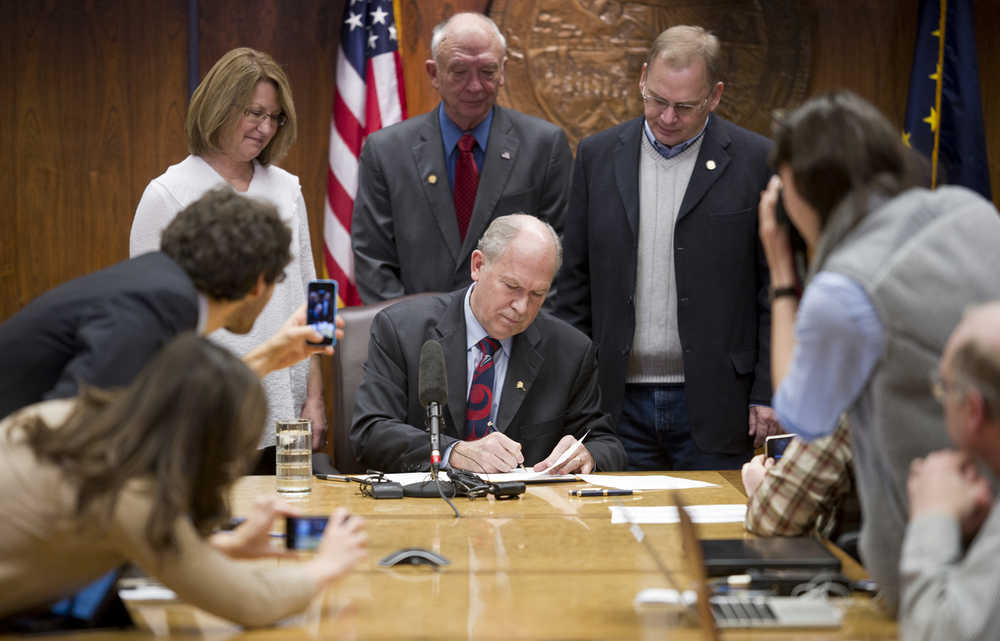Gov. Bill Walker was all smiles as he signed a bill that will give Alaska one-quarter ownership of a natural gas pipeline — once it’s built.
Walker signed the legislation Thursday, a day after the House voted 39-0 to approve spending $161.25 million to buy out TransCanada’s share of the proposed pipeline during special session.
“It was a vote for Alaska’s future is what it was,” he said before putting pen to paper. “Nobody is against the pipeline — nobody in the Legislature, nobody in this building.”
AKLNG, as the pipeline project is known, is expected to generate as many as 10,000 construction jobs if work begins in the mid-2020s, and current estimates indicate the state will earn about $1 billion to $1.2 billion per year in revenue once gas begins flowing.
As envisioned, AKLNG includes construction of an 800-mile natural gas pipeline from the North Slope to an export terminal on the Cook Inlet at Nikiski at the cost of $45 billion to $65 billion. The state partnered with North Slope oil and gas companies BP, ConocoPhillips and ExxonMobil to pay that price and build AKLNG. It’s expected to supply 5 percent of the world’s natural gas once completed, according to state officials.
The state’s share of the project is estimated to be between $12 billion and $18 billion, and in return for spending that sum, it takes one-quarter of all gas that flows through AKLNG.
The state originally entered into an agreement with Canadian pipeline builder TransCanada to avoid paying up front for its share in the project. Under the terms of the agreement, TransCanada would have payed all of the state’s direct costs until construction began, then half of the state’s share of construction costs. In return, the state was to give TransCanada a cut of its revenue once gas starts flowing. With the buyout, Alaska now avoids repaying TransCanada’s costs plus 7.1 percent interest, as outlined in the contract.
BUDGET CUTS,
TAXES STILL NEEDED
While Walker smiled as he talked to reporters Thursday about the advance of the long-term AKLNG natural gas project, his first major accomplishment since being elected governor in 2014, he was serious as he talked about the problems facing Alaska in the coming year.
With the 49th state facing a $4 billion per-year deficit due to low oil prices, drastic action will be needed to make ends meet.
“There most likely will be some form of revenue that most likely will be a tax of some sort,” Walker said.
But what about budget cuts?
“Absolutely,” Walker said.
“It’s in pencil, not pen at this point,” he added. “I really can’t be any more specific than that.”
Walker has until Dec. 15 to release his budget for the next fiscal year, which runs July 1, 2016 to June 30, 2017.
“It’ll be as soon as possible, but no later than Dec. 15,” he said of the budget’s release.
The state has $9.09 billion in the Constitutional Budget Reserve and another $7 billion in the Permanent Fund earnings reserve, each accessible through a vote of the Legislature and necessary to keep the state running as long as there is an annual deficit.
While AKLNG promises billions in revenue, it isn’t expected to begin construction until the end of the decade and even the most optimistic estimates don’t have it producing gas before 2025.
When the Legislature returns to Juneau in January, it will face decisions on the state’s deficit and other aspects of the pipeline project.
The second session of the 29th Alaska Legislature begins Jan. 19.

